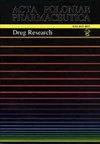In vitro antioxidant, anti-inflammatory activities and acetylcholinesterase inhibition properties of selected plant extracts
IF 0.4
4区 医学
Q4 PHARMACOLOGY & PHARMACY
引用次数: 0
Abstract
Plant extracts remain an infinite source of bioactive chemicals and an inexhaustible resource for discovering new drugs of natural origin. Thus, in this study, we focused on analysing 29 ethanolic extracts (E1-E29) from selected plants of flora of Poland to assess their antioxidant, anti-inflammatory and acetylcholinesterase inhibitory properties in relation to the chemical profiles of phenolic compounds. The results show that the investigated samples differed in terms of their chemical compositions and biological activities. The extract from Cirsium palustre leaves (E13) possesses the highest phenolic and flavonoid contents as well as antiradical activity in the DPPH (2,2-diphenyl-1-picrylhydrazyl) test (415.28 ± 2.22 µM of Trolox equivalent). On the other hand, the most potent anti-inflammatory agents (at 125 µg/mL) were extracts from Odontites vulgaris herbs (E24), with a COX-2 (cyclooxygenase-2) inhibition percentage of 74.54 ± 0.77, and Erigeron acris flower heads (E22), with a 15-sLOX (soybean 15-lipooxygenase) inhibition percentage of 42.45 ± 3.32. All extracts exhibited moderate acetylcholinesterase inhibitory activity. Moreover, to the best of our knowledge, the present study is the first to report phytochemical and pharmacological analyses of extracts from Anthericum ramosum and Lysimachia europaea.选定植物提取物的体外抗氧化、抗炎活性和乙酰胆碱酯酶抑制特性
植物提取物仍然是生物活性化学物质的无限来源,也是发现天然新药的取之不尽的资源。因此,在本研究中,我们重点分析了29种乙醇提取物(E1-E29),以评估其抗氧化、抗炎和乙酰胆碱酯酶抑制特性与酚类化合物的化学特征有关。结果表明,所调查的样品在化学成分和生物活性方面存在差异。在DPPH(2,2-二苯基-1-苦酰肼)实验中(Trolox当量为415.28±2.22µM),鸢尾叶提取物(E13)的酚类、类黄酮含量和抗自由基活性最高。另一方面,牙齿草提取物(E24)对COX-2(环氧化酶-2)的抑制率为74.54±0.77,Erigeron acris花头提取物(E22)对15-sLOX(大豆15-脂氧化酶)的抑制率为42.45±3.32,抗炎活性最强(125µg/mL)。所有提取物均表现出中等程度的乙酰胆碱酯酶抑制活性。此外,据我们所知,本研究是第一个报道的植物化学和药理学分析的花椒和Lysimachia europaea提取物。
本文章由计算机程序翻译,如有差异,请以英文原文为准。
求助全文
约1分钟内获得全文
求助全文
来源期刊
CiteScore
0.80
自引率
0.00%
发文量
74
审稿时长
6-12 weeks
期刊介绍:
The international journal of the Polish Pharmaceutical Society is published in 6 issues a year. The journal offers Open Access publication of original research papers, short communications and reviews written in English, in all areas of pharmaceutical sciences. The following areas of pharmaceutical sciences are covered: Analysis, Biopharmacy, Drug Biochemistry, Drug Synthesis, Natural Drugs, Pharmaceutical Technology, Pharmacology and General.
A bimonthly appearing in English since 1994, which continues “Acta Poloniae Pharmaceutica”, whose first issue appeared in December 1937. The war halted the activity of the journal’s creators. Issuance of “Acta Poloniae Pharmaceutica” was resumed in 1947. From 1947 the journal appeared irregularly, initially as a quarterly, then a bimonthly. In the years 1963 – 1973 alongside the Polish version appeared the English edition of the journal. Starting from 1974 only works in English are published in the journal. Since 1995 the journal has been appearing very regularly in two-month intervals (six books a year). The journal publishes original works from all fields of pharmacy, summaries of postdoctoral dissertations and laboratory notes.

 求助内容:
求助内容: 应助结果提醒方式:
应助结果提醒方式:


